It was starkly obvious from a very young age that Quinten Mathie would follow his father Phillip into trucks. As a boy, he thrived in his father’s shadow, copying everything he did, especially in the ways of operating and respecting big machinery. But now, the boy is a man forging his own future and despite cruel circumstance, resilience and an unfailing work ethic remain the lifelong values of a proud and stoic family.
What you read here is an indulgence and I make no apology for it. It is the story of a close friend who is totally blind and his only son, and their abiding passion for trucks and family heritage. Nonetheless, it is a difficult story to tell because it mixes the inherently opposing loyalties of a strong personal relationship with the responsibility to report the challenges and pressures of an enterprising family business.
But it is, above all else, a story of human spirit and the strength of family. My hope, and only hope, is to do it justice. SB
***********************
On my office wall hangs a large framed photo of two little boys under broad-brimmed hats, their backs to the camera, sitting on a big log. One almost six years old, the other barely a year older, their gaze stuck on a truck and trailer loaded with hardwood logs.
The truck they’re so intently focussed on is a black ‘Super Star’, the 1000th Western Star sold in Australia, with the words Bruce Mathie & Sons on the doors. The year is 1993, the place a timber mill at Lawler’s Creek on the Princes Highway, just a few kilometres north of the pretty town of Narooma on the NSW south coast, and even fewer kilometres from the Mathie base in a quiet industrial cul-de-sac on the outskirts of the little village of Dalmeny.
Out of shot in the background, two fathers smile at the sight of their sons being captured in an image of little boys and big boys’ toys. The symbolism is strong and the photo will eventually adorn calendars and the walls of corporate offices from Canada to the US and Australia.
The younger of the two lads is my son, Dane. The other is Quinten Mathie, the only child of logging operator, Phillip Mathie. Time and circumstance will ultimately take each of the boys along completely different paths but with surprisingly similar levels of initiative and the brash, sometimes troubling boldness of youth, both will carve highly satisfying, rewarding careers of their own choosing.
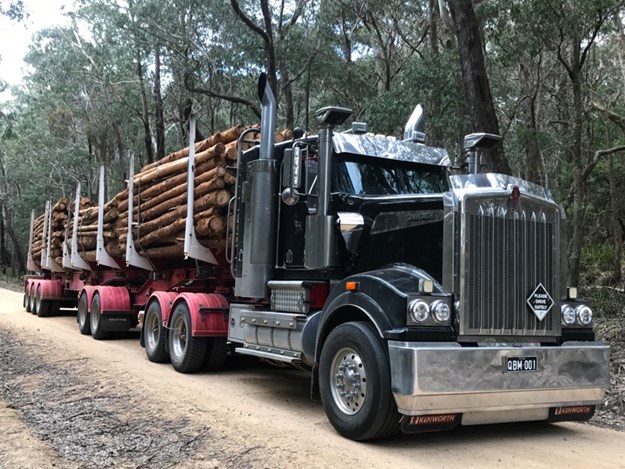 |
|
New generation. Quinten Mathie bought his first truck in 2009 at just 23 years of age. Despite a strong family allegiance to Western Star, his choice of a Kenworth T908 was based purely on practicality
|
Right at that moment though, I had no idea what future endeavours would entice my son. There was, however, little uncertainty surrounding Quinten’s direction, even at such a tender age. Rarely shy about expressing an opinion, he already knew exactly what he wanted to do and I don’t doubt his parents knew it, too. Especially Dad!
Indeed, except for those days when his mother Jenny levered their son to school, Quinten was either in a truck with his father, in the workshop or begging for a chance at the controls of an excavator or bulldozer. He was, in every sense, born to a life of trucks and heavy machinery, and if it wasn’t his father being hounded to the edge of tolerance, it was Phillip’s trusted and highly capable workmate, the late Merv Breust taking the youngster under his burly wing. For the young Mathie, skilful mentors were never far away and critically, lessons were not without a firmly enforced discipline for safety.
Yet Quinten is not, of course, peculiar to a hands-on upbringing in a family business. There are many young men and women with similar stories, sourcing solid livelihoods from the collective influences of personal initiative and the example and experience of forebears who, in instances such as the Mathie’s, stretch way back to the days of drays and four-legged force.
Quinten is, in fact, the fourth generation of a prominent south coast family involved in logging and haulage, starting with great grandfather John Mathie’s bullock team pulling logs out of the bush around the family’s historic home at Wandandian, today just a 20 or 30 minute drive south of the district centre at Nowra.
 |
.jpg) |
|
Time travel. From bullocks to bulldozers, then trucks. John Mathie ‘steers’ a bullock team into Wandandian in 1935 (top) and more than a decade later, his son Bruce at the controls of his first ‘dozer, hauling an early truck out of trouble (above)
|
Likewise, Quinten’s grandfather Bruce Mathie also hauled logs with a bullock team while on Jenny’s side of the family tree, his maternal grandfather was equally a well-regarded axeman. Yet while naïve nostalgia might paint a somewhat picturesque, even idyllic image of these early days, it was often a life of hardship and financial struggle. As the family story goes, the depression years of the 1930s saw Bruce Mathie mustering and droving cattle before moving back to log felling and eventually buying his own bullock team.
Mechanical muscle, however, was on the rise and in 1946 Bruce bought his first tractor for snigging logs, followed by a White ‘Super Power’ truck in 1948. The White connection would run particularly strong, and stay strong, in the second of Bruce’s four sons, Phillip.
The 1960s were a time of change, no less in the Mathie household in Wandandian when opportunity saw logging displaced by a milk haulage business that grew to seven trucks, hand loading and unloading milk cans from dairy farms in and around the district. As Phillip remembers, the family milk business went well until the evolution of bulk tankers and while his father wasn’t against the move into tankers, it seems milk co-ops were against contractors moving into the tanker trade.
Ironically, tankers would many years later become an integral part of Quinten’s future, but fuel rather than milk.
Anyway, left with few options, Bruce returned to the forests and as his sons reached working age, the modest enterprise developed into Bruce Mathie & Sons. The mould was set.
Similarly though, while Quinten’s early days were spent in the shadow of his father, it’s a smiling Phillip Mathie who reflects on his own childhood and youth where almost every waking moment was spent with own father.
“Yeah, I suppose it’s a bit of history repeating itself,” he says with a soft laugh. “I just enjoyed being with Dad. There was always something to learn from him.”
Bruce Mathie passed away in 1980 at 61 years of age and even now as Phillip closes in on his 70th birthday, the emotion stirs close under the skin. “He’d worked hard but I know he would’ve liked to have done a bit more. He still had plenty to give. For sure!”
Quiet for a few moments, it’s a sombre Phillip who adds quietly, “He was just a really good bloke to be around.”
Southern Stars
Since our first meeting in the mid ’80s when Bruce Mathie & Sons became an early supporter of a Western Star brand struggling for resurrection from the ashes of White, Phillip has become a loyal and much admired friend. In at least one instance many years back, he was also a generous coach as he handed over the wheel of a fully loaded log truck to teach the finer features of operating Spicer’s versatile but somewhat quirky 20-speed transmission. It was a classic example of ‘easy when you know how’, and the lesson was never forgotten.
By the time of Quinten Bruce Mathie’s arrival in September 1986, his father and uncles (Kevin, Gill and Stuart) had in separate ways steadily built the family business into arguably the most prominent logging enterprise on the NSW south coast. The mainstay of the business had long been the handling of logs with bulldozers and loaders but the purchase in 1981 of a second-hand White Road Boss added haulage to the operation and with Phillip and Gill initially doing much of the driving, trucks quickly developed into an integral part of the business.
The demise of White, however, while especially disappointing to Phillip, posed the question of ‘which truck next, Kenworth or White’s Canadian cousin, the newly introduced Western Star?’
 |
|
Pride and passion. For Phillip Mathie, blindness hasn’t diminished his absolute regard for White trucks and Cat machinery. Nor has it stalled his appreciation and awareness of high quality workmanship
|
With so much White in its heritage, Western Star won with the Mathie purchase in 1984 of a new Cummins-powered Cheyenne 4800 model. An almost identical unit followed a year later and it was a confident Phillip Mathie who said at the time, “There were a few early doubts about whether the Western Star company would last long in Australia … but the two we have are giving us a good run.”
While Western Star’s future back then was still questionable as various negotiations between Australian interests led by high profile Brisbane-based businessman Terry Peabody and the brand’s Canadian connections continued into the 1990s, Mathie’s allegiance to both the truck and Cummins engines remained rock solid. As time and toil continued to show, the allegiance was well founded but somewhat surprisingly, Terry Peabody would come to play a significant role in Phillip Mathie’s future well beyond trucks. A role that, for some, may seem completely foreign to a Peabody reputation for cold, uncompromisingly tough business tactics.
In the interim, however, and in the middle of a global recession in the early ’90s, Peabody shocked the socks off everyone when he bought Western Star Trucks Incorporated which included, of course, its manufacturing facility in Kelowna, British Columbia. It was a decisive swoop which shored up his Australian investment by quickly returning the Canadian offshoot of the former White Motor Corporation to a financially viable and respected builder of high quality trucks.
So viable, in fact, that in 2000 Peabody sold the whole Western Star operation – with the notable exception of the Australian business – to German giant, Daimler Trucks North America.
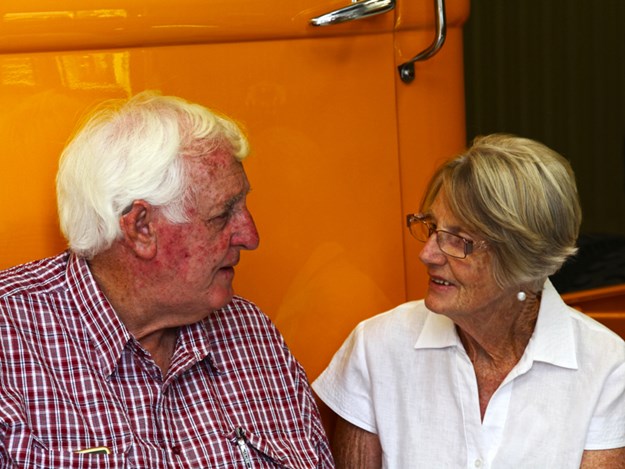 |
|
Phillip and Jenny Mathie. It has been a hard slog at times but devotion and determination are the foundations of an immensely stoic and loyal family
|
Yet throughout much of Western Star’s local history, a friendship was quietly developing which to many, may even now seem unusual. Indeed, it’s a very broad chasm both personally and professionally from the private planes and calculating character of wheelin’ dealin’ billionaire businessmen like Terry Peabody, to the truck cabs and workshops of hard-edged men like Phillip Mathie.
There is, however, a mutual respect and instinctive trust between these two entirely different men which is almost certainly at odds with the perceptions and even understanding of most people. Yet on those occasions when the two are in each other’s company, and long after Peabody’s involvement with Western Star has ended, the mutual regard remains as obvious as it is genuine.
Equally obvious, it’s no surprise that the only new trucks ever bought by Bruce Mathie & Sons were Western Stars, 15 in total. “They’ve always been a good truck for us, so why change?” Phillip asserts before reflecting, “Loyalty works both ways and the people at Western Star have been as loyal to us as we’ve been to them.”
He sits silent for a few moments. “I don’t think there’s a lot of that, loyalty, going around these days.”
Meantime, still never far away from his father or the trucks or the machinery, the teenage Quinten was increasingly itchy to leave high school and start work. His father had left school at 14 to work with his father, so why couldn’t he?
Fair enough, but still several years away from being old enough to hold a licence, the parental proviso insisted on a trade first, and there was no better trade for the 16 year-old Mathie than a four-year diesel fitter’s apprenticeship with Cummins at Queanbeyan near Canberra. “It was one of the best things I ever did,” Quinten would later confirm.
At every level, these were good years for the family and with the fully qualified diesel fitter returning to Dalmeny in 2006 to maintain equipment and drive log trucks for Bruce Mathie & Sons, life appeared to be going exactly the way everyone thought it would.
Still, Quinten was predictably keen to do his own thing and in 2009 at just 23 years of age, he bought his own truck and trailer set to start his own company, sub-contracting to Bruce Mathie & Sons. Fittingly, the company name is QB Mathie, or simply QBM. The new truck chosen to haul a Kennedy Mini-B folding skel trailer was – wait for it – a Kenworth T908 with a 600hp Cummins under the snout.
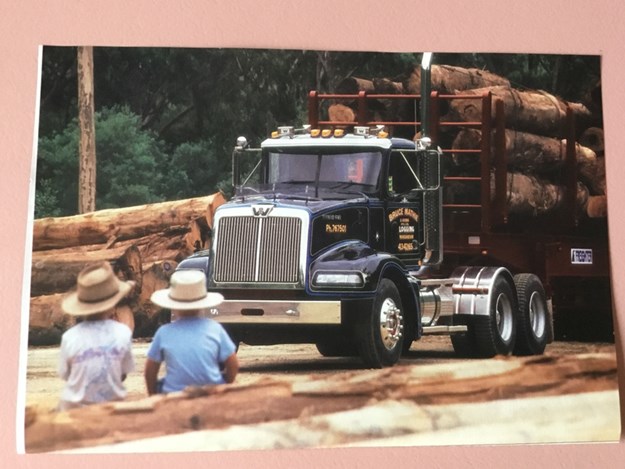 |
|
Flashback to little boys and big boys’ toys. From a tender age, Quinten Mathie already knew what he wanted to do. Drive trucks, just like Dad
|
Nowadays, Phillip smiles at the memory of his son’s first truck being something other than a Western Star, but equally respects and accepts his decision.
“He’s the one who had to pay for it,” he says with a shrug. “Besides, he knew what he was doing.”
For his part, Quinten insists, “There was no real preference for a Kenworth over a Western Star but it was always going to be one or the other. I wasn’t interested in any of the other brands.
“And I’ll tell anyone that Western Star is a good truck. A very good truck, but the 4900 model with the integrated Constellation bunk was too long for the 19 metre B-double skel. Yeah, I could’ve gone for an aftermarket sleeper but I wasn’t keen on that.
“On the other hand, Kenworth had a 28-inch integrated sleeper. It’s not a big bunk by any means but when you’re tired it’s a heap better than the day cab 4900 Western Star I’d been driving for the previous few years.”
However, 2009 was a year when the cycles of change were moving in directions far more intense than simply the choice of trucks.
“It was definitely a big year,” Quinten explains. “I bought my first house, bought my first truck and we (with future wife Tennealle) had our first child.
“But it wasn’t all good because that was also the year Dad started to lose his sight, and lose it quickly.” He stops for a moment. “With so much going on, I probably wasn’t paying as much attention (to his father’s condition) as I should have.
“That still troubles me a bit but you live and learn, aye.”
The Dark Days
It’s a warm, humid Thursday afternoon in mid-February. Phillip is sitting quietly in a corner of the shed, surrounded by the three stunningly restored White Mustangs and the two small dozers which define so much of his pride and passion for White trucks and Cat machinery.
The video crew which has been here most of the day to record the interview of a blind man’s dedication to the immaculate restoration of such classic trucks, has packed up and gone, and now he rests, his hands on the long white stick which helps guide him around obstacles.
Sitting in one of the old trucks, I stupidly shut my eyes and try to imagine what it’s like to see nothing but a curtain of pitch black. Ridiculous! I can open my eyes and see. He can’t.
The latest of the old Whites is a 1955 WC28 model, the biggest and arguably most intricately restored of all three, bought as little more than scrap metal from a wrecker’s yard in the NSW Hunter Valley. Like the petrol-powered 1961 WC22 model and the 4200 model from 1964 with its even bigger bore petrol engine, the WC28 with its Cummins NH220 diesel engine was fully restored by the skilled tradesmen of prominent south coast family company, Cleary Bros.
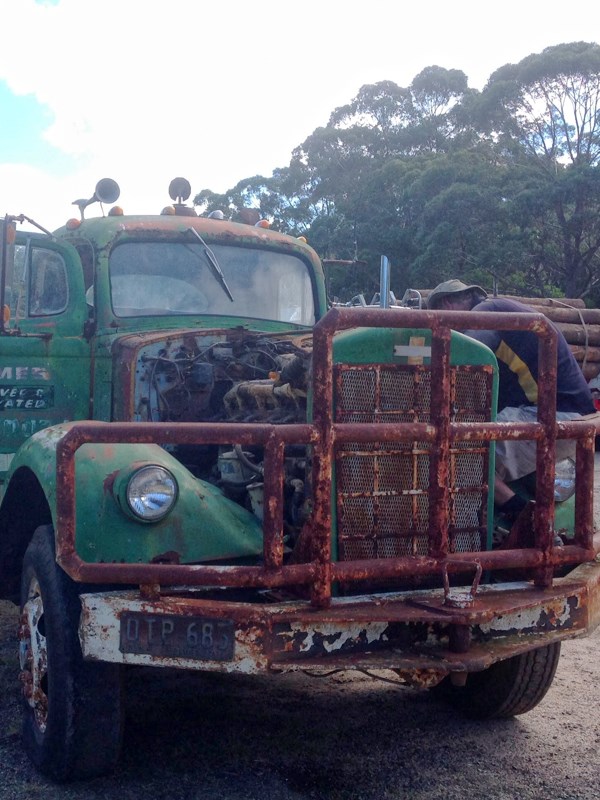 |
 |
|
From this to this. The transformation of the 1955 White WC28 from little more than scrap metal to a stunning piece of trucking history typifies the passion of its owner and the skills of Cleary Bros tradesmen
|
The original Cleary brothers – Denis and his late siblings John and Brian –have been close friends for many decades and Phillip is quick to give credit to the company and its tradesmen for the unquestioning commitment to the remarkable rebirth of his trucks. In the next breath, “Other than my father, I learnt more from John Cleary than anyone. He was a very smart man and a great friend.” It’s high praise from a man who most times keeps his inner thoughts well contained.
Even so, it’s one thing to know every detail of each truck’s specification, but how does a blind man maintain a passion for wonderfully restored machines and critically, be assured of the high standards of the workmanship? His answer is spontaneous and without the slightest hint of doubt. “I can picture it and I can feel it. I can picture what they are and what they need to be.
“I’ve been around trucks all my life, and trucks like these were part of my life as a kid. People tell me how good they look but I can visualise it, too. I reckon if I could see, they’d look exactly how I see them in my mind.
“Besides, I know the blokes at Cleary Bros will do a good job and they’ll do it just the way I ask. They’re good tradesmen but they’re good people, too.”
Still, there’s no escaping the disappointment and the frustration. Here is a man, after all, who worked hard all his life, and loved most things about his working life, hardships and all. A man who drove and operated and understood trucks and heavy machinery as well as any, yet a man who continues to thrive in the company of like-minded, honest people, and once a friend, remains an unwaveringly true friend.
In quiet conversation though, Phillip admits he’s fully aware that some people are unable to relate to him the way they did when he had his eyesight. “It’s a bit annoying really. I’ve known some of these people for a very long time,” he says sharply. “I’m still the same person, I still know the same things, but I think they just can’t handle talking to a blind man. It’s as if they don’t know what to say anymore. I might be blind but I’m not bloody deaf or stupid and if it worries them, they should try it from my side.”
He seems relieved to get that off his chest.
The blindness is caused by a condition called anterior ischemic optic neuropathy and for Phillip, its first effects were felt in 2009. Most times, as wife Jenny explains, sight in at least one eye can be saved but it is extremely rare that both eyes are affected to the point of complete blindness.
Despite the best efforts of many specialists including top ophthalmic doctors in the US introduced through Terry Peabody’s connections, nothing could be done and by Christmas 2010, Phillip was completely blind. It was, of course, a brutal hit and coping mechanisms came in many forms, but none greater than the incredible stoicism of an intensely loyal wife and resolute family.
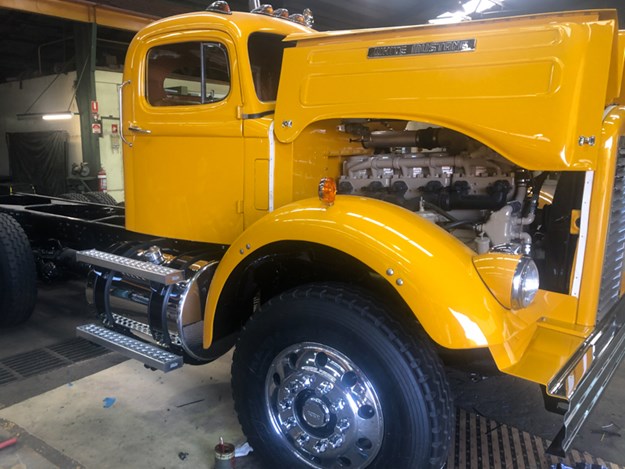 |
 |
|
The Cummins NH220 engine runs as sweet as it looks while the finish on the inside of the ’55 White is brilliant, right down to the rosewood fascia in the centre of the dash
|
“It is what it is, so you just have to do what you can,” Phillip says with flat acceptance. The bitterness dwells deep and is rarely exposed. “Not much good whinging about. Or not whinging too much,” he snickers.
Jenny drives him to and from the shed most days and when it’s quiet around the office he’s often feeling his way around the old trucks or sometimes wandering among parked trucks and trailers in the yard. He’s never far away from the machinery that is, and will always be, such a foundation of his life. Critically though, technology plays its part with a highly advanced phone which allows him to easily source people and information and as he puts it, “To just stay in touch.”
Quiet for a few moments, he says candidly, “The worst thing, I suppose, is the disappointment.
“It’s disappointing and it gets frustrating that I can’t give Quinten a hand when he needs it. If I could still see, I could do a load for him now and again, give him a break, or just do a bit of work on a truck or trailer.
“That’s a big disappointment because he’s had to do a lot on his own. I know he’s capable and he can do lots of things but it would’ve been good to help him. Besides, I miss driving. A lot.”
Fire and Pestilence
By 2016, the family company was effectively finished and it’s a seemingly untroubled Quinten who shrugs when asked if his father’s condition and the wind-down of Bruce Mathie & Sons put added pressure on him or his own ambitions. Collecting his thoughts, the response was typically firm. “It was difficult with everything that was happening then, but Dad’s condition was what it was and we couldn’t change anything, as frustrating and upsetting as it was.
“I think about it a lot, for sure, and it was absolutely disappointing for both of us.
“Suddenly, all that ability was stripped away. For 23 years I’d seen what he could do and learned so much from him, then to have it taken away wasn’t easy. But it was an awful lot harder for Dad, and Mum too. No doubt.”
 |
|
Hauling north out of Cobargo, the south coast village is still recovering from the tragedy of bushfires. Kenworth K200 is the truck of choice for QBM’s B-double tanker combinations. South of home base at Narooma, B-doubles are still limited to an overall length of 19 metres on the Princes Highway
|
As for the pressure, he says simply, “There was pressure, I guess, but you do what you have to do. I’ve always been taught to just get on with it.” And that’s exactly what he’s done.
Yet he is equally quick to mention that he’s not the only Mathie of his generation to run trucks, with cousins Luke and Heath also operating their own trucks.
“It must be in the blood,” he says with a smirk.
With the inevitability of Bruce Mathie & Sons coming to an end, the opportunity in late 2013 to add the fuel industry to existing logging and woodchip work was snapped up with Quinten’s acquisition of a fuel haulage operation which included a Detroit Series 60-powered Freightliner Argosy and two tankers.
It was, he resolutely confirms, “a good move” and while the Freightliner cab-over is something of an odd-bod among its much preferred Kenworth and Western Star counterparts, it at least continues to earn a respectable living for QBM. On the other hand, with the Series 60 EGR engine proving typically troublesome, it was ultimately replaced with an ISX Cummins.
Today, QBM operates eight trucks – three Western Stars, the Argosy and four Kenworths consisting of two T9s including his original T908, and two K200 cab-overs coupled to 19 metre B-double tanker sets.
The specialist demands of logs, woodchips and fuel haulage mean most units work in one form of freight or the other but a couple such as his original ’908 and an immensely loyal 1997 Western Star ‘Heritage’ model (nowadays largely a back-up truck) are equipped to swap from one application to the other.
Asked what workload dominates the business, he says the ratios vary. “The dynamics of fuel and logs are entirely different and they can change quickly depending on circumstances.”
The last 15 months or so have, for instance, been particularly tough on both applications, starting with the devastating fires of late 2019 and early 2020 which had a blatant impact on logging operations.
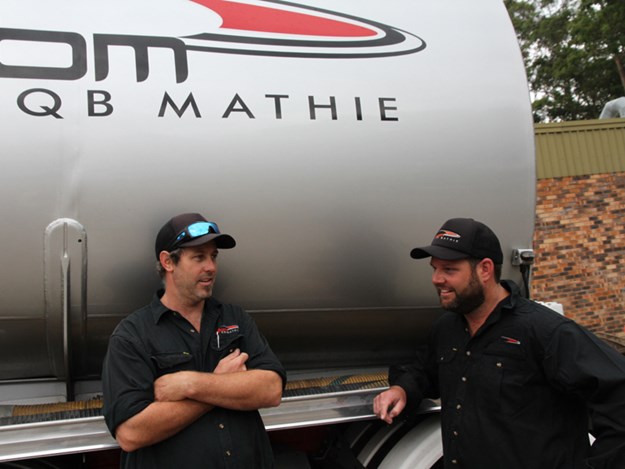 |
|
Quinten Mathie (left) with good mate and good driver, Shannon Doherty. For Shannon and a 19 metre B-double loaded with fuel, deadly fires on the south coast came too close for comfort on one particularly nasty day
|
“The whole south coast was alight from Nowra down to the border,” Quinten explains as we drive through the small town of Cobargo where a year earlier, fires took a severe toll on life and property. Today, the town still carries the scars and there’s much work remaining but it’s a modest Quinten Mathie who casually mentions there was no shortage of work for two of his tanker combinations during the fires, hauling water almost non-stop over several months to fire tankers and large water pods used for reloading helicopter buckets.
For driver and close mate Shannon Doherty, the fires came a tad too close for comfort as night and blinding smoke settled in on one particularly nasty day, punching a B-double load of fuel ahead of a fast moving fire front as Police were closing the road behind him. “The smoke was really bad and I never knew whether I would run into fire around the next bend,” he now calmly recalls. “There was no mobile phone service and the UHF was useless over distance. I just had to push on as hard as I could.
“It’s something I’m in no hurry to do again, that’s for sure.”
As Quinten adds though, these were difficult days and difficult things had to be done. The diesel bowser at the Mathie depot, for example, became one of very few refuelling points in the entire district for emergency services vehicles.
Yet no sooner were the fires out, then COVID-19 hit and this time, with almost no traffic moving anywhere along the coast for months, the normally busy fuel haulage operation went into an unwelcome hiatus.
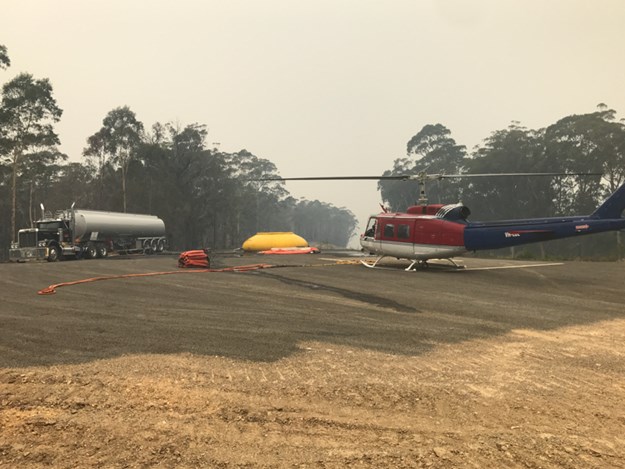 |
|
For several months from late 2019 to early 2020, several Mathie tankers were committed to keeping water supplies up to fire appliances on the ground and in the air
|
“Like I said, the dynamics are entirely different and they can change very quickly,” Quinten remarks with a shrewd grin and a maturity which seems to have softened the abrupt and occasionally antagonistic mannerisms of earlier years.
Still, it’s a familial trait that he does not suffer fools easily, setting high standards for himself and consequently, others. As his wife Tennealle attests from the Mathie office, “No one is harder on Quinten, than Quinten.”
Likewise, a formidable work ethic either in the cab of a truck or swinging spanners in the workshop is a characteristic moulded in early childhood.
“I have my own standards,” Quinten continues, “and I suppose that can make me hard to work for at times, so I have to remind myself that not everyone has had the same background or experience I’ve had.
“The fuse definitely isn’t as short as it used to be, so I guess I’ve learned something about tolerance,” he says with a wry grin.
Sitting quietly a few metres behind his son, Phillip listens and suddenly, the same grin appears.
The similarities run deep and from somewhere in the cranial cavern, the thought hits me, ‘I never knew Bruce Mathie but I reckon he’d be proud. Very proud.”


.jpg)